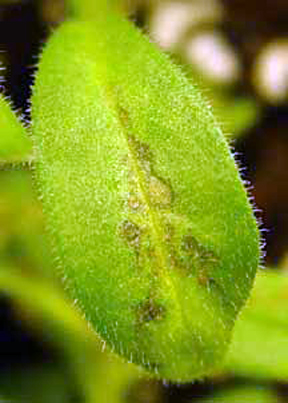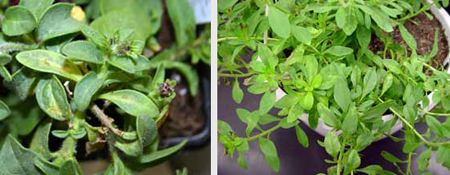Tobacco mosaic virus 2007
Editor’s note: This article is from the archives of the MSU Crop Advisory Team Alerts. Check the label of any pesticide referenced to ensure your use is included.
Tobacco mosaic virus (TMV) has a very wide host range including petunia, calibrachoa, lobelia, impatiens, chrysanthemums, geraniums and tomato. Symptoms caused by TMV vary greatly depending on the host. Symptoms may include, yellowing of the foliage, necrotic leaf spots, mosaic symptoms, stunting and leaf distortion.

Photo 1. Tobacco mosaic lesions on a leaf.

Photos 2 and 3. Tobacco mosaic damage on a petunia plant.
Unlike some of the other common viruses of ornamentals, TMV is not vectored by insects. The virus can be spread by sap, through vegetative plant production and through mechanical means. Smoking should not be permitted in production areas because tobacco products can carry TMV.
Fungicides are not helpful in controlling plant diseases. Once plants are infected with a virus, they can not be treated to eradicate the virus. Infected plants should be removed and destroyed. Identifying infected plants can sometimes be challenging. MSU’s Diagnostic Services lab can test samples for TMV with ELISA testing. Samples should be submitted with next day delivery and should not be mailed on a Friday. Overnight delivery is recommended because several samples mailed recently with slower delivery options were frozen when they arrived at the lab.
Click here (www.pestid.msu.edu) to learn how to submit a sample, or contact me (517-355-3504) if you have any questions about submitting samples or the testing procedure.
Common TMV Hosts
| Begonia | Geranium | Osteospermum |
| Calibrachoa | Impatiens | Petunia |
| Chrysanthemum | Lobelia | Tomato |
| Gazania | New Guinea Impatiens | Verbena |



 Print
Print Email
Email


